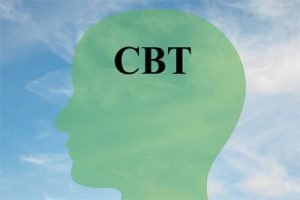By Barry Keate
Barry Keate, has lived with tinnitus over 40 years and has published 150+ research articles on numerous aspects of tinnitus. He is an expert on the condition and a well-known advocate for those with tinnitus.
 Cognitive behavioral therapy (CBT) is a form of psychological counseling that focuses on thoughts, how those thoughts interact with behaviors, and how those behaviors interact with feelings. It provides skills to people to reduce internal attention to tinnitus and improve coping by devising alternative thought and behavior patterns that help to distract and habituate to the tinnitus sound. (1)
Cognitive behavioral therapy (CBT) is a form of psychological counseling that focuses on thoughts, how those thoughts interact with behaviors, and how those behaviors interact with feelings. It provides skills to people to reduce internal attention to tinnitus and improve coping by devising alternative thought and behavior patterns that help to distract and habituate to the tinnitus sound. (1)
New evidence shows internet-based Cognitive Behavioral Therapy (iCBT) is as fully effective as face-to-face meetings with therapists in reducing aggravation and distress.
Cognitive behavioral therapy is not designed to reduce the loudness of tinnitus. Rather, it is intended to reduce the aggravation and distress of the tinnitus sound. If a person is not bothered by the tinnitus, it ceases to be a problem. In this regard, it is similar to Tinnitus Retraining Therapy (TRT), however without the sound generator.
CBT has proven to be effective for depression, anxiety disorders, and a vast array of other medical conditions including diabetes and irritable bowel disorder. It has also proven effective in a variety of pain conditions when the pain cannot be controlled by medication.
CBT is now commonly used for tinnitus either by itself or in conjunction with TRT, Neuromonics, biofeedback, tinnitus masking and other management strategies. It can also be a helpful addition to the use of Arches Tinnitus Formulas.
Cognitive Behavioral Therapy in Practice
Robert Sweetow, PhD, is an Audiologist at the University of California, San Francisco (UCSF) Department of Otolaryngology. He and his group were the first, in 1982, to integrate a cognitive behavioral approach into a tinnitus management protocol. (2)
Dr. Sweetow describes CBT as follows: One of the main components is cognitive restructuring, a method of rethinking the problems caused by tinnitus into a form that does not contribute to its severity. In other words, it assists patients to think differently and alter their attitudes about the problem. The other component is behavior modification. This consists of identifying factors that contribute to the problem and the patient’s reaction to it and finding ways to modify them through behavioral changes.
A brief overview of the therapy consists of the following steps:
1 – Define the problem. Is it bothersome only at night? Does the patient stay at home when the tinnitus is bad?
2 – Identify behaviors and thoughts affected by the tinnitus. Is the patient angry? Is the patient depressed or suicidal?
3 – List dysfunctional strategies and cognitive distortions. All humans indulge in these distortions but the tinnitus patient perhaps more so. The more common ones are all-or-nothing thinking, overgeneralization, jumping to conclusions, emotional reasoning, disqualifying the positive, and catastrophic thinking.
4 – Distinguish between the tinnitus and the dysfunctional tinnitus behavior. A refusal to socialize results from the dysfunctional behavior, not the tinnitus itself.
5 – Identify alternate thoughts, behaviors and strategies. Show the patient that even those long ingrained irrational thoughts cannot persist when scrutinized logically. For each thought there is an alternate thought. The effectiveness of this can be shown by helping the patient set up alternate possibilities that will undergo mutually agreed upon testing.
6 – Devise and rehearse strategies that can be measured. Homework assignments are given and structured to allow the patient to test progress. Assignments may consist of maintaining a daily loudness and annoyance chart, diaries, and recording of maladaptive thoughts.
7 – Regularly assess success or failure of coping strategies. Initial goals should be modest and success should be achievable with reasonable ease. When a strategy fails to produce success, it should not be viewed as a failure but as part of the learning process of what will and will not work for that patient.
CBT should produce success within 6-8 weeks. If no progress has been made during this period, this approach is probably not going to be successful.
It is helpful to provide the patient with proof that changes are occurring. Biofeedback can be used for this as it displays objective results on a computer screen. It has been shown to be independently useful for tinnitus patients. It is effective in facilitating relaxation and to help identify and alter physical stress points that contribute to tinnitus exacerbation.
Dr. Sweetow determines which treatment strategy is appropriate for a given tinnitus patient by use of a multidisciplinary team approach. A team has been assembled at UCSF that includes audiologists, otologists, temporomandibular joint specialists, psychologists, psychiatrists, physical therapists, biofeedback specialists, pharmacologists and nutritionists.
Clinical Studies on Cognitive Behavioral Therapy
Clinical studies have been performed on CBT. A Cochrane Review of eight trials involving 468 participants found no evidence of tinnitus loudness being reduced. However, they did find evidence that quality of life scores and depressions scores were improved. (3)
A German study on 286 tinnitus patients with stable tinnitus levels for at least four months showed 84% of the active group had improvement compared to 22% of controls. The secondary outcome measure of tinnitus questionnaire score and annoyance score improved in the treatment group significantly more than the control group. In the treatment group the tinnitus questionnaire score was reduced by 50% from a median of 27 to 13.5. (4)
A recent study from the UK compared 88 tinnitus patients who were divided between the internet-based intervention (iCBT) online and conventional face-to-face therapy care at 3 UK-based National Health Service hospitals. The internet-based therapy was pioneered in Sweden and adapted for the UK study.
The results of the study revealed that both interventions are equally effective for reducing tinnitus distress and most tinnitus-related difficulties. (5)
Cognitive behavioral therapy is most often practiced by psychologists or clinical social workers. In many cases these will be the same professionals who also practice biofeedback. They can be found by searching on the web or by finding a therapist at the Academy of Cognitive Therapy at www.academyofct.org or by email at [email protected].
The internet-based therapy is not currently available to the public. Queries can be made to the Academy of Cognitive Therapy at the above link.
References:
1 – Shannon Robinson, MD. Cognitive Behavioral Therapy – The Basics. American Tinnitus Association, Tinnitus Today. December 2005.
2 – Sweetow R. The evolution of cognitive-behavioral therapy as an approach to tinnitus patient management. Int’l Tinnitus J. Vol. 1, No. 1, Jan/Jun 1995, pp 61-65.
3 – Martinez-Devesa P, et al. Cognitive behavioral therapy for tinnitus. Cochrane Database Syst Rev. 2010 Sep 8;(9):CD005233.
4 – Zenner P, Vonthein R, et al. Standardized tinnitus-specific individual cognitive-behavioral therapy: a controlled outcome study with 286 patients. Hear Res. 2013 Apr;298:117-25.
5 – Beukes EW, Andersson G, et al. Effectiveness of Guided Internet-Based Cognitive Behavioral Therapy vs Face-to-Face Clinical Care for Treatment of Tinnitus: A Randomized Clinical Trial. JAMA Otolaryngologists/Head Neck Surgery. 2018;144(12):1126-1133.
Get Free Shipping!
Order now and get free shipping on either the Tinnitus Starter Kit or Combo Pack. Try the doctor recommended products with clinically proven ingredients for tinnitus. No coupon code required.

